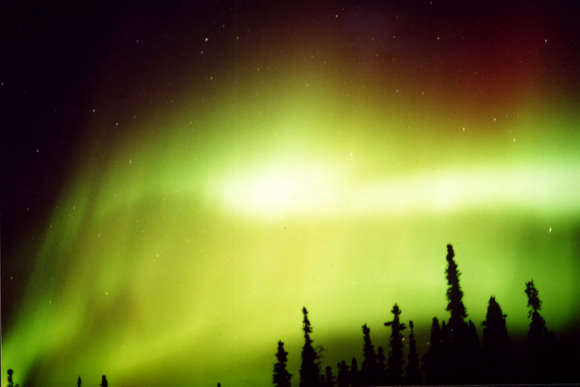[/caption]
The aurora (plural aurorae) borealis has many other names: northern lights, northern polar lights, polar lights, and more. An aurora borealis is light seen in the sky, nearly always at night, in the northern hemisphere, commonly green but also red and (rarely) other colors; often in the shape of curtains, sheets, or a diffuse glow (when seen from the ground). Northern lights are most often seen at high latitudes – Alaska, Canada, northern Scandinavia, Greenland, Siberia, and Iceland – and during maxima in the solar cycle.
Aurora australis – southern lights – is the corresponding southern hemisphere phenomenon.
Seeing a bright auroral display may be on your list of ‘things to see before I die’! Yep, they are nature’s light show par excellence.
Aurora borealis occur in the Earth’s ionosphere, and result from collisions between energetic electrons (sometimes also protons, and even heavier charged particles) and atoms and molecules in the upper atmosphere. The ultimate origin of the energy which powers the aurora borealis is the Sun – via the solar wind – and the Earth’s magnetic field. Interactions between the solar wind (which carries its own tangled magnetic fields) and the Earth’s magnetic field may cause electrons (and other particles) to be trapped and accelerated; those particles which do not escape ‘downstream’ to the magnetic tail ‘touch down’ in the atmosphere, close to the north magnetic pole.
The different colors come from different atoms or ions; green and red from atomic oxygen, nitrogen ions and molecules make some pinkish-reds and blue-violet; purple is the appearance of combined colors from nitrogen ions and helium; neon produces the very rare orange. The ionosphere is home to most aurorae borealis, with 100-300 km being typical (this is where green is usually seen, with red at the top); however, some particularly energetic particles penetrate much deeper into the atmosphere, down to perhaps 80 km or lower (purple often comes from here).
Viewed from space, when the northern lights are intense they appear as a ring (an oval actually), the auroral zone, with the north magnetic pole near the center.
The University of Alaska Fairbanks’ Geophysical Institute has a good FAQ on the aurora borealis.
Magnetic fields plus solar wind … so you’d expect aurorae on Jupiter and Saturn, right? And auroral displays around the magnetic poles of these planets are now well documented. Aurorae have also been imaged on Venus, Mars, Uranus, Neptune, and even Io.
Some Universe Today stories on aurorae – borealis, australis, … and extra-terrestrial: What are the Northern Lights?, Aurora Reports from Around the World, Behind the Power and Beauty of the Northern Lights, Northern & Southern Aurorae Are Siblings, But Not Twins, Two Rockets Fly Through Auroral Arc, Chandra Looks at the Earth’s Aurora, First Aurora Seen on Mars, and Saturn’s “Dualing” Aurorae.

